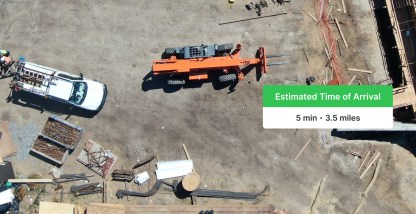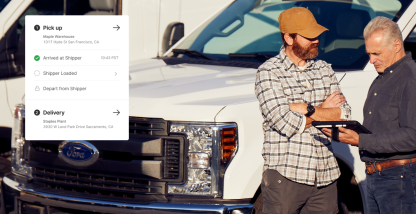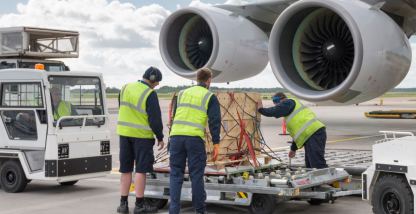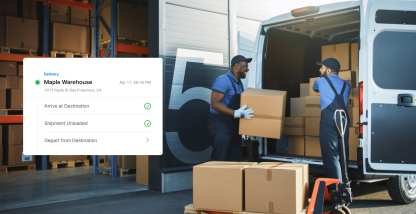The future is here. Robots are delivering medicine in hospitals. Drones are dropping off food orders straight to your door. Logistics companies are also investing in autonomous trucking to help address last-mile delivery challenges. This article explores the state of autonomous trucking today and the potential benefits and drawbacks that this technology can offer to logistics enterprises.
What is autonomous trucking?
Autonomous driving trucks are commercial vehicles that rely on technology to get from point A to point B. The person in the driver’s seat is replaced by artificial intelligence (AI) automation and machine learning (ML), which draw data inputs to travel on highways and other public roads between shipping yards and warehouses to the long-haul destination.
How do autonomous trucks work?
Autonomous trucking technology uses long-range, high-resolution sensors and the power of AI/ML to follow the established delivery route and account for any obstacles on the road. Autonomous driving technology processes the sensor data to perceive objects in real time. The technology can recognize traffic signs, emergency vehicles, and other vehicles on the road.
People supervise autonomous driving systems in current pilot programs, but the technology is meant to learn. As the machine’s neural networks process more routes, operation without human supervision can become a future reality.
Key elements of autonomous trucking technology
According to McKinsey, the autonomous trucking industry is likely to develop in four waves. Already there are platooned autonomous trucks with drivers handling the non-interstate highway driving.
In phase two, a single driver is in the lead truck and a second truck follows along the interstate highway route. A second driver takes the wheel of the autonomous truck on non-interstate highways.
The consultants predict the next stage will see autonomous trucks platooning on the highway, maybe even more than two trucks, with drivers involved at pickup and drop-off. Finally, driverless trucks will eliminate the need for human involvement at any point in the journey.
Benefits of autonomous trucks
There are several benefits of autonomous trucks. Here are the main advantages to consider.
Streamlines delivery
Federal regulations limit the number of hours a driver can work without taking a break. Under Federal Motor Carrier Safety Administration (FMCSA) regulations, drivers may only drive a maximum of 11 hours after 10 consecutive hours off duty. There are no similar limitations for autonomous truckers, which leads to faster delivery.
Helps combat driver shortage
Trucking moves the majority of all goods shipped in the United States. However, the American Trucking Association (ATA) predicts a need for 160,000 drivers by 2028. The autonomous trucking industry is one effort to address the shortfall. Autonomous trucks don’t need to be recruited nor retained. Plus, they don’t have to adhere to federal requirements about the amount of time spent on the road and behind the wheel.
Reduces costs
McKinsey estimates “with full autonomy, operating costs would decline by about 45 percent, saving the US for-hire trucking industry between $85 billion and $125 billion.” While the capital expenditures will rise with purchase of the trucks, the company’s balance sheet will be dramatically impacted.
In Deloitte’s estimation, autonomous trucking has the potential to lower per-mile costs by 30% or more.
Autonomous truck companies will also enjoy greater fuel savings from optimized routes. Plus, taking driver behaviors out of the equation can cut down on fuel consumption.
Lowers carbon emissions
Self-driving trucks make logistics greener. The autonomous tech can reduce fuel consumption by up to 40% and optimize asset performance to cut carbon emissions. It’s also anticipated that autonomous trucking will make electric trucks more viable, which can further help fleets meet their sustainability goals.
Improves safety
Automated driving trucks aim to deliver safety benefits. The U.S. National Highway Traffic Safety Administration states automated vehicles have the potential “to save lives and reduce injuries” since “94% of serious crashes are due to human error.”
After all, a machine won’t fall asleep at the wheel, look away from the road in a moment of distraction, or run a red light.
Better driver experience
With autonomous trucking, drivers can enjoy better working conditions. The self-driving trucks can handle the long-haul routes that take people away from family and friends. The technology can take the wheel while a driver sleeps. Autonomous technology works best on the routine and mundane tasks. Exactly the type of driving that bores the human driver.
Drawbacks of autonomous driving trucks
Autonomous trucks offer many advantages. Still, there are some potential pitfalls. For one, the technology isn’t as reliable in fog or snowy weather conditions.
Additionally, the technology requires robust wireless connections. The adoption of high-speed 5G wireless is in the works, but it will take longer in some areas of the country. In places without 5G, wireless remote driving will be much more difficult.
Cybersecurity is another concern. The manufacturers need to develop autonomous trucks with robust security in place to counter the risk of vehicle systems getting hacked.
Lastly, drivers are still needed to drive autonomous trucks in cities and urban environments, as the software can’t navigate at the moment.
Challenges facing the autonomous trucking industry
In addition to the concerns about road conditions, cybersecurity, and public acceptance, autonomous trucks also have greater stopping distances. They need to “see” much further ahead down the road to be able to react in time. The trucks are often cab-less, but the standard 18-wheel truck can still weigh up to 40 tons, which could be hazardous on the road.
Self-driving trucks will also require supervision, at least from the outset. That means new jobs monitoring the autonomous truck driving industry. But first, people need to be trained to do so effectively.
When will autonomous trucks be on the road?
There isn’t a conclusive answer to when autonomous trucks will be on the road. Several sources predict it will happen in the next decade. Still, Chris Spear of ATA suggests it will be closer to 20-25 years before autonomous trucks are used widely.
Still, there’s no question that the technology is in the works and progress is being made. Automated trucks are completing successful experimental runs in the United States, Europe and China. In one pilot program from Plus, self-driving truck technology company, the supervised autonomous trucks operated over over 62,000 miles without issue.
How will self-driving truck technology transform the logistics sector?
Self-driving truck technology is likely to make its biggest impact in last-mile delivery. The rapid growth of the e-commerce industry has seen an increased demand for flexible, fast, traceable, and personalized last-mile delivery.
However, meeting customer expectations is costly. Fuel costs are high. Failed deliveries or having to store warehouse shipments can be expensive. Idling, down time, and out-of-route miles also cut into profits.
Autonomous trucking can help tackle these logistics challenges with optimized route planning and the ability to keep trucks on the road for more hours and greater distances without worrying about the driver’s fatigue or Hours of Service compliance.
The move to autonomous trucking can also impact liability and safety regulations.
How Motive’s route optimization software can help autonomous trucking companies
When the transition to autonomous trucks happens, logistics enterprises will need to track and map their assets. Optimizing autonomous trucking routes can help companies recoup their investments.
Motive helps optimize dispatch and workflow by enabling smarter route decisions. Our route optimization software considers customer time windows, vehicle capacity, traffic congestion, the distance between stops, and other variables to maximize efficiency.
The software uses advanced algorithms to accurately decide which are the most time-efficient routes to follow, eliminating human error and making drivers’ lives easier. Plus, drivers get a full view of driving time between each stop and any potential obstructions.
Motive’s software enables fleet managers to access real-time and historical route and driver data as well as vehicle safety insights. With weather and traffic overlays, you can improve productivity and safety too.
At Motive, our focus is helping commercial fleets of all types and sizes become better, smarter, and more effective. Learn more today.









